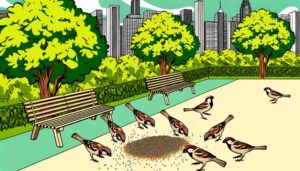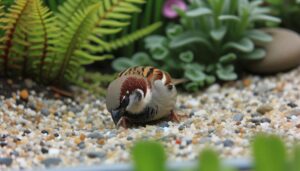How to Identify Genetic Differences in House Sparrows Between US and European Populations
Genetic differences between house sparrows in the US and Europe are influenced by evolutionary history, natural selection, and local environmental factors. European sparrows typically exhibit larger body sizes and muted plumage, while American sparrows display brighter colors and greater dietary diversity.
Variations in metabolic rate and immune response highlight genotype-environment interactions. Modern sequencing techniques reveal allelic differences, particularly in disease resistance genes like those against avian malaria and West Nile virus.
Adaptive divergence driven by climatic and urban pressures underscores their evolutionary resilience. Further insights into their physiological and genetic adaptations await in subsequent sections.

Key Takeaways
- European sparrows are generally larger in size compared to American sparrows.
- American sparrows exhibit brighter plumage colors than their European counterparts.
- European sparrows have genetic adaptations for colder climates, while American sparrows adapt to a wider range of temperatures.
- American sparrows show higher resistance to West Nile virus, whereas European sparrows have adaptations against avian malaria.
- Diet differences exist, with European sparrows primarily consuming grains and seeds, while American sparrows have a more varied diet including insects and human food waste.
Genetic Origins
How did the genetic variations observed in house sparrows arise and contribute to their adaptability across diverse environments?
The genetic diversity in house sparrows (Passer domesticus) is primarily attributed to natural selection and genetic drift, driven by environmental pressures.
Detailed observations show that these variations enhance adaptability by influencing traits such as beak morphology, immune response, and metabolic rate.
Comparative analysis reveals that house sparrows exhibit significant genotype-environment interactions, enabling them to thrive in both urban and rural settings.
For instance, alleles associated with resistance to pathogens prevalent in urban areas have become more common. Such genetic adaptations underscore the evolutionary resilience of house sparrows, facilitating their widespread distribution and successful colonization in varied climatic zones.
DNA Sequencing Techniques
To elucidate the genetic differences among house sparrow populations, modern sequencing methods such as Next-Generation Sequencing (NGS) have been employed to generate high-resolution genomic data. These advanced techniques facilitate thorough comparative genomic analysis, enabling researchers to identify specific genetic variations and evolutionary patterns.
The resulting data provides critical insights into population structure and adaptive divergence, underscoring the utility of cutting-edge sequencing technologies in avian genetics.
Modern Sequencing Methods
Advancements in modern sequencing methods, such as next-gen sequencing (NGS) and single-molecule real-time (SMRT) sequencing, have revolutionized the ability to analyze genetic differences in house sparrows with unparalleled accuracy and depth.
These technologies enable extensive genome assemblies and high-capacity sequencing, facilitating the identification of minute genetic variations. NGS offers rapid sequencing of large DNA fragments, while SMRT sequencing provides long-read capabilities, essential for resolving complex genomic regions.
Comparative Genomic Analysis
Comparative genomic analysis employs advanced DNA sequencing techniques to systematically investigate genetic variations and evolutionary relationships among house sparrow populations. By analyzing high-throughput sequencing data, researchers can identify single nucleotide polymorphisms (SNPs), insertions, deletions, and other genomic features that differentiate American and European sparrows. This comparative approach elucidates adaptive evolution, divergence times, and gene flow patterns, offering insights into how environmental pressures shape genetic diversity.
| Technique | Application |
|---|---|
| Whole Genome Sequencing | Thorough genetic landscape analysis |
| RNA Sequencing | Gene expression profiling |
| SNP Genotyping | Identification of genetic variation |
| Comparative Genomics | Evolutionary relationship assessment |
| Metagenomics | Microbial community analysis in sparrow habitats |
These methodologies provide a robust framework for understanding the genetic architecture of house sparrows across continents.
Evolutionary Timeline
The evolutionary timeline of the House Sparrow (Passer domesticus) reveals a complex history of adaptation and diversification across various geographical regions. Fossil evidence suggests these birds originated in the Middle East approximately 10,000 years ago, coinciding with the advent of agriculture.
This species' close association with human settlements facilitated its rapid spread to Europe and subsequently to other continents. Genetic studies indicate notable divergences between European and American populations, likely due to founder effects and subsequent isolation.
Moreover, comparative genomic analysis reveals specific alleles linked to regional environmental pressures, highlighting the role of natural selection. These divergences underscore the intricate interplay between genetic drift and adaptive evolution in shaping the House Sparrow's global distribution.
Adaptation to Climate
In response to varying climatic conditions, House Sparrows have exhibited significant physiological and behavioral adaptations, enabling them to thrive in diverse environments. European House Sparrows show morphological changes such as larger body size and denser plumage, which are advantageous in colder climates.
Conversely, sparrows in warmer climates, such as those in the United States, tend to have smaller bodies and less dense plumage, aiding in heat dissipation. Additionally, metabolic rates differ; colder climates induce higher metabolic rates to generate body heat, while warmer climates favor lower metabolic rates to conserve water.
These adaptations exemplify how House Sparrows have genetically diverged to survive and reproduce in disparate climatic conditions, reflecting their remarkable ecological plasticity and evolutionary success.
Diet and Nutrition
House Sparrows exhibit a highly variable diet that reflects their adaptability to different ecological niches and availability of resources. European and American house sparrows demonstrate dietary preferences that vary based on local environmental conditions. European sparrows primarily consume grains and seeds, while their American counterparts exhibit a more diverse diet, including insects and human food waste. Comparative analysis reveals that diet variations are influenced by urbanization levels and agricultural practices in respective regions.
| Region | Primary Diet Components |
|---|---|
| Europe | Grains, Seeds |
| North America | Insects, Human Food Waste |
| Urban Areas | Mixed Diet (grains, seeds, food scraps) |
These dietary differences underscore the species' remarkable ability to exploit available resources efficiently, reflecting their genetic adaptability.
Migration Patterns
Contrary to many migratory bird species, house sparrows exhibit largely sedentary behavior, with only minor seasonal movements observed in certain populations. In Europe, house sparrows may display short-distance migration, particularly in northern regions where harsh winters necessitate limited travel to milder areas.
Conversely, North American populations generally remain stationary year-round, with minimal displacement. This variation in migratory behavior could be attributed to climatic conditions and availability of resources. Genetic studies suggest that the observed differences in migration are not purely behavioral but may also involve genetic predispositions.
Despite these minor movements, house sparrows' overall sedentary nature presents an intriguing subject for further research into how environmental pressures and genetic factors interplay in shaping avian migration patterns.
Breeding Behaviors
While migratory behaviors vary among populations, breeding behaviors in house sparrows exhibit remarkable consistency across different geographical regions. Both European and American house sparrows display monogamous pair bonding, typically forming breeding pairs that may last multiple seasons.
Nesting preferences include cavities in buildings or natural structures, and both sexes contribute to nest construction. Clutch sizes generally range from 3 to 5 eggs, with both parents partaking in incubation and chick rearing. Comparative analysis reveals minimal divergence in courtship displays, such as male song and territorial defense.
This behavioral uniformity suggests that breeding strategies in house sparrows have been evolutionarily conserved despite genetic differences. Such consistency underscores the species' adaptability and successful colonization in diverse environments.
Physiological Traits
Notable physiological traits among house sparrow populations exhibit significant variations, particularly in plumage coloration and body size, reflecting adaptations to their specific environmental contexts.
European house sparrows (Passer domesticus) tend to exhibit more muted plumage compared to their American counterparts, which display brighter and more varied feather patterns. Additionally, body size differences are evident; European sparrows are generally larger, a trait possibly linked to Bergmann's rule, which posits that larger body sizes are advantageous in colder climates.
These variations are not merely superficial; they influence behavior, mating success, and survival rates. Such physiological divergence underscores the intricate relationship between genetic adaptations and environmental pressures, emphasizing the importance of understanding these traits in the broader context of evolutionary biology.
Disease Resistance
House sparrows exhibit varying degrees of disease resistance across different populations, a phenomenon largely attributed to their genetic diversity and the specific pathogens prevalent in their respective environments.
In European populations, genetic adaptations have been observed that enhance resistance to avian malaria, a common pathogen in the region. Conversely, North American house sparrows display heightened resistance to West Nile virus, reflecting their exposure to this particular pathogen.
Comparative genomic studies reveal significant allelic variations in immune-related genes between these populations. Such genetic divergence underscores the evolutionary pressures exerted by region-specific diseases.
Importantly, these findings highlight the role of localized environmental factors in shaping the immunogenetic landscape of house sparrows, underscoring the intricate interplay between genetics and disease resistance.
Future Research
Future research should focus on elucidating the molecular mechanisms underlying the observed genetic variations in disease resistance among house sparrow populations. This endeavor is essential for understanding the evolutionary adaptations that differentiate European and US sparrows.
Detailed genomic sequencing and functional analyses will be crucial.
Comparative studies should aim to:
- Identify key genetic markers associated with disease resistance.
- Analyze gene expression patterns in response to common pathogens.
- Investigate the role of epigenetic modifications in adaptive immunity.
- Examine environmental factors influencing genetic divergence.
- Develop predictive models to forecast future evolutionary trends.
Such thorough investigations will not only enhance our knowledge of avian genetics but also inform broader ecological and conservation strategies.
Understanding these mechanisms can evoke a deeper appreciation for the complexity of evolutionary biology.
Conclusion
The comparative analysis of the genetic origins, DNA sequencing techniques, evolutionary timeline, and adaptation to climate reveals remarkable distinctions between the house sparrows inhabiting the United States and Europe.
Differences in diet, nutrition, breeding behaviors, physiological traits, and disease resistance underscore the species' specialized survival strategies.
Such scientific scrutiny sets the stage for further research, fostering a fuller understanding of these fascinating finches' evolutionary intricacies and ecological adaptations.
Future findings promise profound insights into avian biodiversity and resilience.





